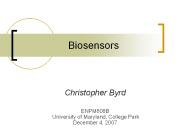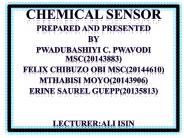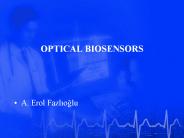Biosensors PowerPoint PPT Presentations
All Time
Recommended
1-56 of 1,536
The global biosensors market is estimated to grow at a CAGR of 10.00% to reach $22.68 Billion by 2020
| PowerPoint PPT presentation | free to download
Title: Biosensores Author: Mitolab Last modified by: Patricia Meade Created Date: 12/19/2001 4:56:34 PM Document presentation format: Presentaci n en pantalla
| PowerPoint PPT presentation | free to download
Coli bacteria Biochip array E. Coli bacteria Bioluminescence The emission of light by a living organism as the result of a chemical reaction.
| PowerPoint PPT presentation | free to download
... (DNA) Carbon nanotube BioFET Whole Cell Basic functionality Benefits/Challenges Summary References Introduction Biosensor: ...
| PowerPoint PPT presentation | free to download
A chemical sensor is a device that transforms chemical information (composition, presence of a particular element or ion, concentration, chemical activity, partial pressure.) into an analytically useful signal. The chemical information, mentioned above, may originate from a chemical reaction of the analyte or from a physical property of the system investigated. They can have applications in different areas such as medicine, home safety, environmental pollution and many others.
| PowerPoint PPT presentation | free to download
Browse Complete Summary and Table of Content @: https://www.htfmarketintelligence.com/report/global-biosensors-market
| PowerPoint PPT presentation | free to download
Title: Biosensores Author: Mitolab Last modified by: Mitolab Created Date: 12/19/2001 4:56:34 PM Document presentation format: Presentaci n en pantalla
| PowerPoint PPT presentation | free to download
Anthony Catalano Any device that analyzes a biological compound into a measurable signal Composed of a bioreceptor, transducer, and an electronic peripheral ...
| PowerPoint PPT presentation | free to download
and the effect of parameter variations on these quantities.' System : ... BP, LAP, Urine output, Chest tube drainage. Automated protocol for blood infusion -- Rules ...
| PowerPoint PPT presentation | free to view
... by sandwich immunoassay for detection by a fluorescence microtiter plate reader and microscopy ... liposomes in a sandwich hybridization assay for Dengue ...
| PowerPoint PPT presentation | free to view
Biosensors, Polyaniline & Carbon NanoTubes
| PowerPoint PPT presentation | free to download
The biosensors market was valued at $17,500.0 million in 2018 and is expected to reach $38,600.2 million by 2026, registering a CAGR of 10.4% from 2019 to 2026.
| PowerPoint PPT presentation | free to download
Biosensors Market are increasingly penetrating medical, environmental, food process, and biodefense application markets.
| PowerPoint PPT presentation | free to download
ELECTROCHEMICAL BIOSENSORS Modern and future approaches to medical diagnostics J. F. Rusling Dept. of Chemistry Dept. of Pharmacology, Univ. of CT Health Center
| PowerPoint PPT presentation | free to view
Are you interested in the latest trends, applications, challenges, and advancements in biosensors? Join the Global Webinar on Biosensors, where researchers, scientists, doctors, practitioners, students, and industry professionals will come together to discuss the fundamentals of biosensors, the role of nanotechnology, various types of biosensors, and their applications in fields such as medical and healthcare, drug discovery, environmental monitoring, food industry, and more. The webinar will also cover topics such as wearable and implantable biosensors, immunosensors, MEMS-based biosensors, nucleic acid-based biosensors, enzyme-based biosensors, and 3D printing technologies in biosensor production. Don't miss this opportunity to acquire vital insights into this quickly growing industry and explore the newest technologies and trends that are driving growth and innovation. Register now and be part of this dynamic platform for cross-sectoral collaboration!
| PowerPoint PPT presentation | free to download
Main Components Of An Optical Biosensor (i) a light source (ii) an optical transmission medium (fiber, waveguide, etc.) (iii) ...
| PowerPoint PPT presentation | free to download
... Enzymatic Reactions for Glucose Analysis Thermometric Sensors Thermopile-based Enzyme Probe Optical Sensors Electrochemical Sensors So Why Is This Useful?
| PowerPoint PPT presentation | free to view
ELECTROCHEMICAL BIOSENSORS Modern and future approaches to medical diagnostics J. F. Rusling Dept. of Chemistry Dept. of Pharmacology, Univ. of CT Health Center
| PowerPoint PPT presentation | free to view
The term “biosensor” is short for “biological sensor.” The device is made up of a transducer and a biological element that may be an enzyme, an antibody or a nucleic acid. The bio element interacts with the analyte being tested and the biological response is converted into an electrical signal by the transducer. The emergence of nanotechnology-based biosensors, significant technological advancements in the last few years, increasing use of biosensors to monitor glucose levels in individuals with diabetes, surging demand for home-based point of care devices due to the COVID-19 pandemic, and rising government initiatives toward diagnostics are some of the factors that have supported long-term expansion for Biosensors Market.
| PowerPoint PPT presentation | free to download
Allow us to examine Chemistry at high resolution at solid-liquid & liquid-liquid ... For more info, contact http://www.chinstruments.com/index.html ...
| PowerPoint PPT presentation | free to view
Easy to fabricate. Disadvantages. Oxygen consumption(solved) Protein adsorption ... Fabricate outer membrane surface of electrodes. Self Assembled monolayer (SAMs) ...
| PowerPoint PPT presentation | free to view
Better Enzymes for Biosensors Or, A Tale of Two Saucy Little Peroxidases Or, Improving Proteins With New Tools & Old Ciar n F g in School of Biotechnology ...
| PowerPoint PPT presentation | free to download
Title: Test Author: BIOMED Last modified by: Mustafa Sualp Created Date: 9/12/2000 3:32:02 PM Document presentation format: On-screen Show Company
| PowerPoint PPT presentation | free to view
The latest report by Precision Business Insights, titled “Photoplethysmography Biosensors Market” covers complete information on market size, share, growth, trends, segment analysis, key players, drivers, and restraints.
| PowerPoint PPT presentation | free to download
Discrete optical components (laser, photodetector, and filters) Serial ... Progress: Design of Monolithically Integrated Laser, Photodetector, and Filter ...
| PowerPoint PPT presentation | free to view
The Global Biosensors Market size is expected to reach $34.3 billion by 2025, rising at a market growth of 8.6% CAGR during the forecast period. Biosensors are devices which combine biological components for detecting an analyte and a physicochemical component in order to produce a measurable signal. Currently, the most common biosensors are home pregnancy tests and glucose detectors. There is however, a drive to produce novel biosensor technologies for several applications like food analysis, deoxyribonucleic acid testing, and drug detection. Thin films make these sensors increasingly small and with fewer detection limits. Full Report: https://www.kbvresearch.com/biosensors-market/
| PowerPoint PPT presentation | free to download
Fabrication of Nanoscale BLM Biosensors. Tadahiro ... Fabrication of a stable platform for transducing signals through ... Substrate Fabrication ...
| PowerPoint PPT presentation | free to download
Surface Plasmon Resonance Biosensors Characteristics of SPW Characteristics of SPW Surface Plasmon Resonance --- SPR is a real-time ...
| PowerPoint PPT presentation | free to view
According to the latest research report by IMARC Group, The global biosensors market size reached US$ 28.8 Billion in 2023. Looking forward, IMARC Group expects the market to reach US$ 55.4 Billion by 2032, exhibiting a growth rate (CAGR) of 7.3% during 2024-2032. More Info:- https://www.imarcgroup.com/biosensors-market
| PowerPoint PPT presentation | free to download
The global biosensors market is estimated to grow at a CAGR of 10.00% to reach $22.68 Billion by 2020.
| PowerPoint PPT presentation | free to download
The Global Biosensors Industry 2015 Deep Market Research Report is a professional and in-depth study on the current state of the Biosensors industry. The report provides a basic overview of the industry including definitions, classifications, applications and industry chain structure.
| PowerPoint PPT presentation | free to download
Biosensors Market categrizes the Global market by Type, Product (Wearable, Non-wearable), Technology, Application (POC, Home Diagnostics, Research Lab, Environmental Monitoring, Food & Beverages, Biodefense) and Region. COVID-19 Impact on Biosensors Industry.
| PowerPoint PPT presentation | free to download
Title: frost.com Author: Janet Cook Last modified by: Frost & Sullivan Created Date: 6/11/1999 8:13:48 AM Document presentation format: On-screen Show
| PowerPoint PPT presentation | free to download
The overall biosensors market is expected to grow from USD 21.2 billion in 2019 to USD 31.5 billion by 2024, at a CAGR of 8.3%
| PowerPoint PPT presentation | free to download
Bioanalytical Microsystems and Biosensors ... Identify specific objectives of a national research program ... Avoiding the spoilage of large quantities of milk ...
| PowerPoint PPT presentation | free to view
Binding isotherms. Simulated isotherms for different c values ... The asymmetry of the isotherm. shows two distinct binding events ...
| PowerPoint PPT presentation | free to view
[191 Pages Report] Biosensors market research report categorizes global market by application (point of care, home diagnostics, research labs, biodefense, environmental monitoring, food industry), product (wearable, non-wearable), technology (electrochemical, piezoelectric, optical) & geography
| PowerPoint PPT presentation | free to download
Immunochemical Methods and Biosensors for pollutants determination (General principles and application) Danila Moscone Department of Chemical Science and Technology
| PowerPoint PPT presentation | free to view
Batch fabrication and. Low cost ... FABRICATION RESULTS - COMPLETE SEQUENCE. Uncompensated mechanical stress ... FABRICATION RESULTS - FINAL DEVICE ...
| PowerPoint PPT presentation | free to download
PLA biodegradation along with BA9 elution. No PLA /BA9 coating on the stent after 6 to 9months ... Elution of BA9 Rue de Lausanne 29 1110 MORGES Switzerland ...
| PowerPoint PPT presentation | free to view
This report studies Nano Biosensors in Global market, especially in North America, Europe, China, Japan, Korea and Taiwan, focuses on top manufacturers in global market, with capacity, production, price, revenue and market share for each manufacturer, covering Analog Devices Nippon Denso Omron Robert Bosch Roche Nimblegen Freescale STMicorelectronics Sensonor AS Toshiba
| PowerPoint PPT presentation | free to download
In the past few years, the demand for point-of-care testing (POCT) has risen considerably, which is further creating need for portable and integrated devices. A POCT is a test which can be performed at or near the site of patient whenever the medical care is required. The technique has become an indicator of in vitro diagnosis, which is ascribed to its rapid, simple, low cost, and portable nature . The patient can be provided with result immediately outside of a laboratory, which is why POCT is also being widely utilized in hospitals as well. POCT further aids in improving patient care through remote patient care monitoring.
| PowerPoint PPT presentation | free to download
[321 Pages Report] Biosensors market research report categorizes global market by application (point of care, home diagnostics, research labs, biodefense, environmental monitoring, food industry), product (wearable, non-wearable), technology (electrochemical, piezoelectric, optical) & geography.
| PowerPoint PPT presentation | free to download
The global Glucose Biosensors market was valued at 3367.7 million in 2020 and is projected to reach US$ 3565.2 million by 2027, at a CAGR of 1.4% during the forecast period.
| PowerPoint PPT presentation | free to download
the total market was valued at $11.39 billion in 2013 and is expected to reach $22.68 billion by 2020, at an estimated CAGR of 10.00% from 2014 to 2020.
| PowerPoint PPT presentation | free to download
Wearable biosensors market research report is forecasted on the basis of revenue analysis of key players of the industry. The report includes industry size, share, trends, opportunity, growth drivers & restraints along with regional segmentation of the market for the forecast period of 2017-2025.
| PowerPoint PPT presentation | free to download
biosensors market is expected to grow from USD 21.2 billion in 2019 to USD 31.5 billion by 2024, at a CAGR of 8.3%
| PowerPoint PPT presentation | free to download
The biosensors industry has witnessed significant technological developments over the last few years. Various studies have been carried out for incorporating the biosensors technology into various clinical and non-clinical applications ranging from medical, biodefense, environment monitoring, and food industry.
| PowerPoint PPT presentation | free to download
The global biosensors market is estimated to grow at a CAGR of 10.00% to reach $22.68 Billion by 2020. Biosensors play a very important role to sense the biological environment and provide qualitative and quantitative data for the real-time analysis
| PowerPoint PPT presentation | free to download
Know More @ http://www.bigmarketresearch.com/global-glucose-biosensors-industry-2016-deep-research-report-market The key industry leaders get a quantitative analysis of the different market segments in terms of market estimations of major segments and sub segments. The study makes an analysis of the business strategies of the leading manufacturers along with the challenges they need to overcome to grow in the industry. The Glucose Biosensors industry report further provides a complete SWOT analysis of the key market players which will help the market participants to understand the changing competitive landscape scenario.
| PowerPoint PPT presentation | free to download
Get more details @ http://bit.ly/2m6ZNv0 Global biosensors market share is significantly competitive in nature. The industry is significantly price-sensitive, and prone to different pricing strategies. Players are constantly engaged in research and development of novel, highly efficient and compact biosensors technologies in order to sustain their leadership position.
| PowerPoint PPT presentation | free to download
DecisionDatabases.com, recently added a new report to its database. United States Medical biosensors Industry 2016 Market Research Report gives a 360 degree view of theMedical biosensors industry.
| PowerPoint PPT presentation | free to download
Medical biosensors are used to analyze biological components with the help of physicochemical detectors. These biosensors monitor health status, disease betterment, and therapeutic treatment outcomes through invasive and non-invasive methods. For more information: http://bit.ly/VHhfrA
| PowerPoint PPT presentation | free to download
According to the latest research report by IMARC Group, The global biosensors market size reached US$ 26.5 Billion in 2022. Looking forward, IMARC Group expects the market to reach US$ 43.0 Billion by 2028, exhibiting a growth rate (CAGR) of 8.2% during 2023-2028. More Info:- https://www.imarcgroup.com/biosensors-market
| PowerPoint PPT presentation | free to download
Biosensors Market Research Report, identifies new revenue opportunity in biosensors industry. The report aims at estimating the market size and future growth of the biosensors based on offering, process, application, vertical, and region
| PowerPoint PPT presentation | free to download
[182 Pages] Biosensors Market Research Report, identifies new revenue opportunity in biosensors industry. The report aims at estimating the market size and future growth of the biosensors based on offering, process, application, vertical, and region
| PowerPoint PPT presentation | free to download
























































